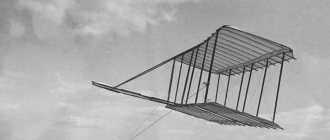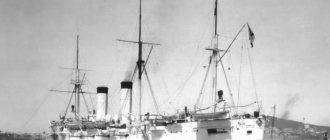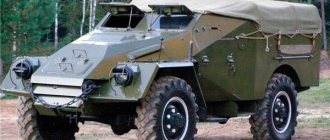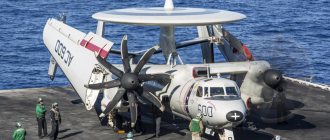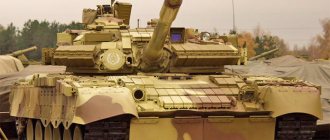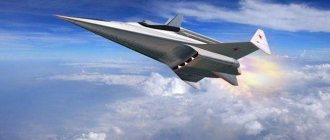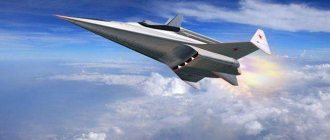Catapult on an aircraft carrier
The first takeoff of an airplane from the deck of a ship took place back in 1910. However, this is nothing more than a conventional name for both the aircraft and the takeoff itself. The plane was a small primitive glider that took off from a specially designed platform measuring 25*7 meters. The Curtiss aircraft, piloted by Eugene Ely, was able to cover a distance of 4.5 km and successfully splashed down; wooden floats allowed it to stay afloat.
Curtiss flying machine 1910
Curtiss flying machine 1910
Such an aircraft could not carry out any combat missions, except reconnaissance and communications with remote units and formations of the fleet. When the technology for re-launching aircraft was mastered, the era of seaplane carriers began.
There were a number of significant technical problems that needed to be solved. In the process of modernizing aircraft and equipping them with additional fuel tanks and heavy machine guns, their weight increased. Acceleration on deck no longer provided the necessary acceleration to obtain takeoff thrust. A launch catapult was developed. These were guides along which acceleration was carried out using a system of cables.
It is worth noting: The first take-off from a catapult took place in 1916 and became possible with the direct assistance in the development of the fathers of all aviation, the Wright brothers. The guide ramp installed on the US aircraft carrier North Carolina was 30 meters long and made it possible to increase the aircraft's take-off speed by 7 times.
Features of modern aircraft carriers
- Aircraft carriers - Comparison by country - History of creation
Varieties
Construction of aircraft carriers
The deck of an aircraft carrier as a type of passive protection for the ship
Launch catapult on an aircraft carrier
Aerofinisher - Aircraft braking system
Nuclear installation on an aircraft carrier
Jets for aircraft carriers
Type of launch catapults on an aircraft carrier
Today, the use of aviation in the naval forces is already a common practice. During combat operations, it is most convenient to use air weapons during attacks. However, at first there was a problem with launching an aircraft from the deck of an aircraft carrier.
The catapult allows you to increase the take-off speed from an aircraft carrier several times. Its first samples operated on the principle of a slingshot - however, this method was not developed. And at the moment there are two versions of this device. Let's look at each of them separately:
- Steam catapult - for acceleration, steam is used, placed in special cylinders under the runway. Guides are mounted at the stern of the ship, through which a cable passes, pulling the fighter along a given line. This cable is attached to a piston located inside the cylinder. Once launched, the steam pushes out the piston, which in turn pulls the plane along with it. As a result, a speed of 250 km/h is achieved - sufficient to lift the aircraft into the sky. Currently, the steam catapult is used on American Nimitz-class aircraft carriers and on aircraft-carrying cruisers of some other countries.
- The electromagnetic catapult is a new aircraft launch system used on the recently launched USS Gerald R. Ford. The device of an electromagnetic catapult consists of: a cable, a guide wheel, a magnetic tube with an iron core, as well as inductive coils and resistors. The operating principle is similar to the previous device, with the aircraft gaining speed under the influence of a magnetic field. The movement and subsequent takeoff of the aircraft from an aircraft carrier is possible strictly along the guide.
With such rapid acceleration, the aircraft produces a huge amount of hot gas. Therefore, before the launch, a special device is raised behind the aircraft - a gas deflector. It protects personnel and necessary technical installations from hot emissions. The operating principle of a steam catapult is significantly inferior to an electromagnetic device. In the second case, when the aircraft is launched, there is no additional steam smoke, which prevents normal visibility from both the pilot and the rest of the personnel. At the same time, there is significantly less chance of emergency situations. Also, modern ejection methods make it possible to increase the take-off speed from an aircraft carrier.
Diagram of the steam catapult structure: 1 - flight deck; 2 - steam cylinder; 3 — brake cylinder; 4 — steam manifold pipe; 5 — starting valve; 6 — shuttle; 7 — tow rope; 8 - delay device.
As time passed and the aircraft gained in numbers, the power of the catapults did not lag behind them. For example, in the 20s of the last century, the catapult on the Maryland ship, having only 24 meters for acceleration, could transfer acceleration to a body of 1.6 tons up to 75 km/h. In the 50s, catapults could accelerate carrier-based aircraft to 200 km/h weighing 6 tons and up to 115 km/h weighing 28 tons. Today, these numbers have remained virtually unchanged because of the enormous pressure that is put on pilots. At the start, they experience overloads of 6 g, which then sharply decrease to 3 g.
Runway length
Most combat aircraft in natural conditions require about 1.5 km of acceleration. If there are no problems with this on land, then at sea a fighter or bomber must lift off in a confined space. The length of the runway on a ship usually does not exceed 200 meters. For example, the Nimitz-class aircraft carriers, which number 10 in US service, have a total vessel length of almost 333 meters, with the runway occupying no more than one-third.
In this regard, military engineers began to develop options for solving this problem. Thus, catapults were designed to allow takeoff from an aircraft carrier. It is worth noting that not all aircraft-carrying ships are equipped with catapults. There is another way to launch aviation - a springboard. Let's talk about it using the example of the Russian aircraft carrier Admiral Kuznetsov.
Onion
The bow is another ancient throwing weapon. Thus, in the Sibudu Cave in the Republic of South Africa (RSA), archaeologists found stone arrowheads about 60,000 years old!
Relief on the rock of Abu Simbel on the banks of the Nile. Pharaoh Ramesses II at the Battle of Kadesh. XIII century BC
The work of the vase painter Epictetus. Scythian archer. Around 520 BC e.
The simplest bow was made from a single piece of wood. There were also composite bows, which consisted of several parts: a more massive central handle and elastic left and right limbs, fastened together. The structure of the bow could be strengthened, for example, by surface weaving from animal veins, and there could be bone or metal inserts at the places where the bowstring was attached.
The bow has two bending arms (upper and lower arms), which, after releasing the tensioned bowstring, return to their original shape due to elastic forces. To launch an arrow further, you need a bow with thicker and longer elastic elements. But you will need to spend more effort to pull the bowstring.
The logical development of all subsequent ancient throwing machines was the use of a bow and sling as their basis. These two hand-held throwing weapons exhaust all the physical principles later applied in more complex devices:
- use of potential energy of a deformed elastic element (bent or twisted);
- lengthening the arm of the throwing lever to increase body speed, as in a sling.
Airplanes taking off from Admiral Kuznetsov
A distinctive feature of the Russian aircraft carrier is the ability to use heavy aircraft on board, which will not be able to take off from American, more modernized nuclear-powered analogues. The ship does not have bulky steam or other catapults; instead, the deck has a springboard with an inclination angle of 14.3°, thanks to which takeoff from an aircraft carrier becomes possible.
Admiral Kuznetsov
In fact, the installation of the springboard was a necessary measure. The catapult required large energy costs, which can be obtained using nuclear installations. The USSR did not plan to build nuclear aircraft carriers. However, such a vessel also has advantages:
- Airplanes can take off from Admiral Kuznetsov in any climate zone, unlike steam catapults, which cannot operate in the Arctic Ocean;
- The absence of any type of catapult significantly freed up space on the ship, as a result, the free space could be used for additional weapons. Thus, the catapult on a Nimitz-class aircraft carrier takes up significant space, as a result of which the ship has only combat aircraft as a powerful weapon. At the same time, Admiral Kuznetsov is equipped with a large number of other missile weapons. That is why the Russian ship is called a heavy aircraft-carrying cruiser.
In Russia, the production of a modern nuclear-powered vessel with combat aircraft on board is still at the planning stage. If construction begins, the electromagnetic catapult on the Russian aircraft carrier will become the optimal device for lifting aircraft.
Gastraphetes
From about the 4th century. BC. in Ancient Greece they began to use gastraphetes (literally translated as “abdominal onion”). This hand-held throwing weapon used a ratchet-like mechanism for winding the bowstring and more powerful elastic arms than a bow. To charge the gastraphetus, you had to rest one end on the ground and press the other with your entire mass with your stomach. Later, among the Romans and in the Middle Ages, such a weapon was called a crossbow, from the Latin arcaballista - “arcus” - arc, “ballisto” - throw.
Loading gastraphetus
Gastraphetes shot heavy and short arrows. Crossbow arrows are commonly called bolts.
Gastraphetes
Ancient Greek eutytons and palitons. Ancient Roman scorpions and ballistas
In order to throw even further, a torsion bar . Torsion throwing machines no longer used the energy of an elastically bent body, but of elastically twisted ropes made from horse hair or animal sinew. But outwardly, such a device resembled a gastraphetus - just like two arms, only in the form of levers, fixed at one end in a bundle of ropes.
In Ancient Greece, throwing machines with a torsion mechanism for arrows were called euthytons (Greek Euthytonon - arrow thrower), and for throwing stones paltons (Greek Palintonon - stone thrower).
Later, in Ancient Rome, light eutytons that shoot arrows began to be called scorpions . And stone throwers were called ballistae .
Palinton is an ancient Greek stone thrower with torsion bars. In ancient Roman - ballista
Ancient Greek euthyton (left) and ancient Roman scorpion (right)
Many people use the word “catapult” to represent medieval siege battering guns that throw cannonballs. Initially, in Ancient Greece, two-armed throwing machines with a torsion mechanism began to be called a catapult. Some sources say that initially in Ancient Greece, a catapult meant only arrow throwers (eutytons), although eutytons could also use small stones instead of arrows. One of the translations of the word “catapult” (Greek καταπέλτης - “katapeltes”) is a derivative of the words “down” and “throw, throw.”
The art of shooting from throwing machines (Greek “katapaltai”) was described around 350 BC by the ancient Greek writer Aeneas Tacticus in a treatise on siege art.
Later, in Ancient Rome, all throwing machines began to be collectively called catapults - the ballista, the scorpion, and the onager. Therefore, in historical sources there is confusion regarding the exact names of certain throwing machines.
